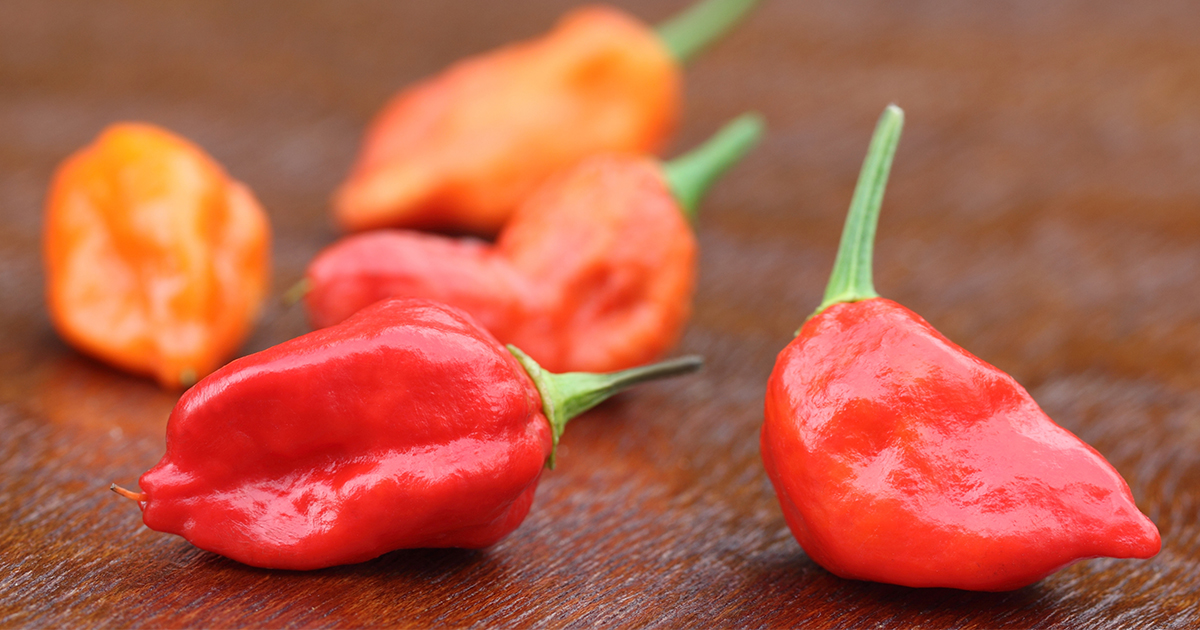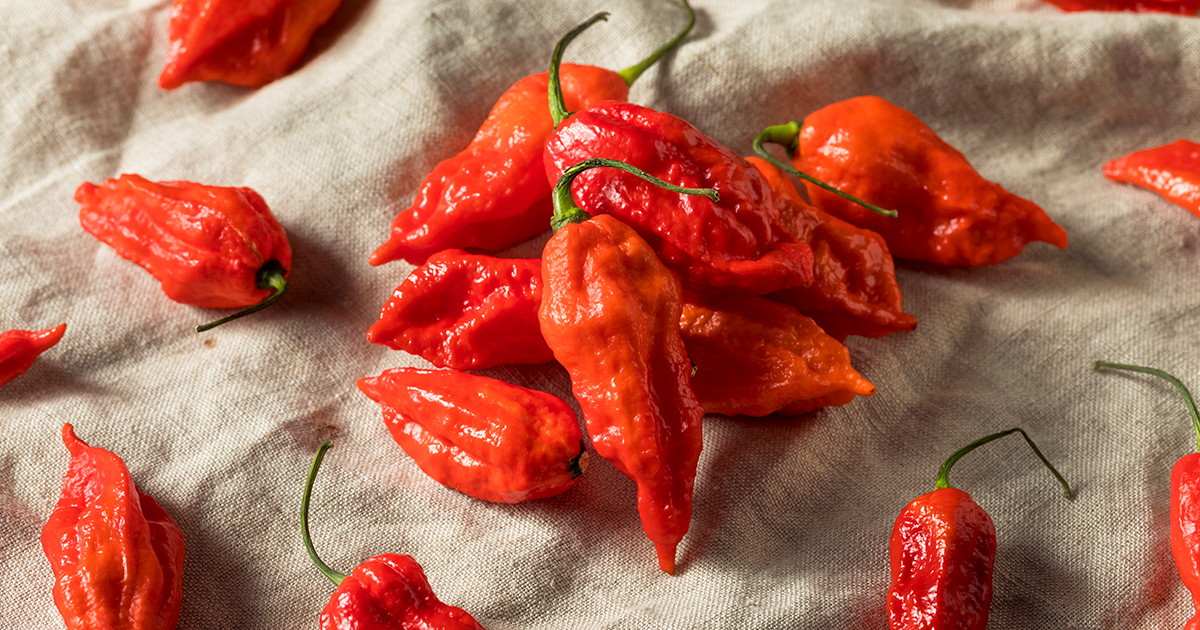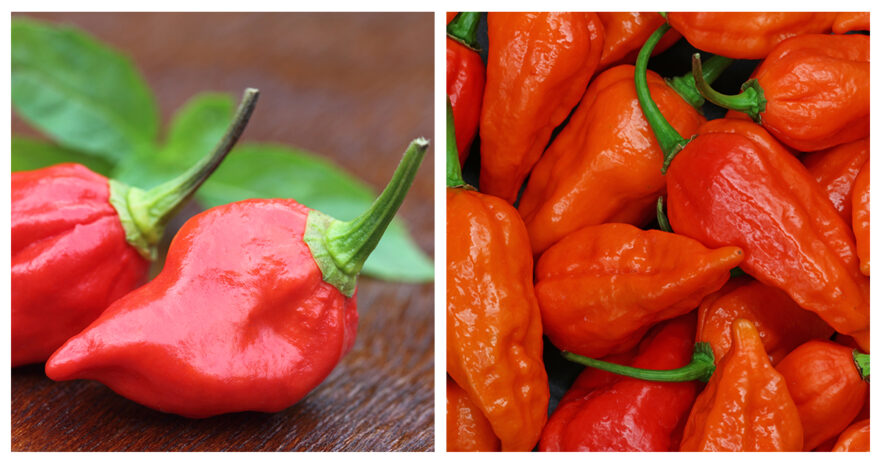If you‘re a fan of spicy food, then you know that chili peppers come in different heat levels and flavors. The Naga Viper and the Ghost Pepper are two of the world’s hottest chili peppers, and they‘ve garnered a whole lot of attention from spice enthusiasts. Both peppers pack a fiery punch, but what sets them apart? In this article, we‘ll compare the Naga Viper vs. Ghost Pepper, delving into their distinct characteristics and finding out which one is the perfect fit for your recipe.
| Naga Viper | Ghost pepper | |
| SHU | 1,382,118 - 1,382,118 | 855,000 - 1,041,427 |
| Median SHU | 1,382,118 | 948,214 |
| Flavor | Sweet, fruity, tangy with a very intense heat | Fruity and slightly sweet, with a very intense heat |
| Species | Hybrid of Capsicum chinense x Capsicum frutescence | Hybrid of Capsicum chinense x Capsicum frutescens |
| Origin | United Kingdom | Northern India |
| Uses | Hot sauces, barbecue sauces, curries, stir-fries etc. | Hot sauces, salsas, curries, pickling, etc. |
Table of contents
What is the Naga Viper?

The Naga Viper pepper is actually a hybrid of three peppers: the Naga Morich, the Bhut Jolokia, and the Trinidad Scorpion. It was developed in England by Gerald Fowler of the Chilli Pepper Company. It was officially recognized as the world’s hottest pepper in 2011 by the Guinness World Records, with a Scoville rating of 1,382,118 SHU.
The Naga Viper pepper comes in a fun shade of bright red and has a bumpy texture on the outside. There’s a fruity and slightly sweet quality to the flavor, with just a hint of citrus and a very notable, lingering spiciness. Because of this, this pepper is frequently used in curries, hot sauces, and stews for intense flavor and heat, but should definitely be used in small doses due to its extreme heat.
Just a tiny little bite of this pepper can cause some insane burning sensations in the mouth and throat, sweating, and tears. Some people even experience heart palpitations and difficulty breathing after eating a Naga Viper.
This little pepper has become so popular that it‘s inspired a few wild challenges and contests, where people compete to see who can eat the most of it. These challenges have especially gained notoriety on social media platforms, where people record themselves eating the pepper and share their reactions with others.
The Naga Viper is definitely a fascinating chili pepper that‘s gained worldwide recognition for its serious heat and unique flavor profile. Even with its popularity, it‘s important to handle this pepper with care and use it sparingly due to its intensity. It’s always better to be safe than sorry!
What is the Ghost Pepper?

The Ghost pepper, also known as Bhut Jolokia, is a hot little chili pepper native to Northeast India. It was once considered the hottest pepper in the world, with a Scoville rating between 855,000 to 1,041,427 SHU, but it‘s since been surpassed by a few other peppers. Despite this change, the ghost pepper is still extremely hot and has a unique flavor profile that makes it a highly popular ingredient in dishes that require a strong hit of heat.
Ghost peppers have a pretty distinctive appearance, with a red or orange color and a bumpy texture. Their fruity and lightly sweet taste makes them a great addition to all sorts of things. They‘re also often dried and ground into a powder, which becomes a common ingredient in spice blends and hot sauces.
One of the reasons the ghost pepper has gained such popularity is its versatility when it comes to cooking. While some people might shy away from the intense heat of the ghost pepper, others absolutely love to use it to add an extra kick to their favorite dishes, whether that be pizza or a nice chili con carne. The trick is to use it sparingly and remember to balance out its heat with other flavors. Also, be sure to handle it with care since the levels of capsaicin from this pepper can cause skin irritation and even burns.
What are the Similarities Between Naga Vipers and Ghost Peppers?
Naga Vipers and Ghost Peppers are easily two of the hottest peppers in the whole world, and they happen to share several similarities.
First of all, both the Naga Viper and the Ghost Pepper are ridiculously hot, with Scoville ratings well above the 1,000,000 SHU mark. In fact, they were each once considered the hottest peppers in the world, with the Ghost Pepper holding the title from 2007-2011 and the Naga Viper taking over for a short period of time in 2011. Although other peppers have since surpassed them, they definitely remain ranked among the hottest peppers around.
Secondly, both of these peppers have a pretty distinctive look, with a bright reddish color and bumpy texture. The Naga Viper pepper is a little bit larger than the Ghost Pepper, but they both have similar shapes.
Third, on the list, both Naga Vipers and Ghost Peppers have a somewhat sweet, fruity taste, often described as being a little citrusy. This flavor profile makes them a popular ingredient in a wide variety of foods. However, their wildly strong heat level means that they should be used sparingly and with caution.
Finally, both peppers have gained worldwide recognition and fanfare. They‘re often featured in spicy food challenges and have been used to create some of the world’s hottest hot sauces. Despite their heat, or sometimes because of it, they have gained devoted followers of chili enthusiasts who appreciate their complex flavors and crazy heat.
What are the Differences Between Naga Vipers and Ghost Peppers?
Despite sharing many similarities, the Naga Viper and Ghost Pepper also have a few key differences.
Let’s start with the most notable, shall we? The Naga Viper and Ghost Pepper have different levels of capsaicinoids, which are the compounds responsible for the peppers‘ heat. The Naga Viper has been tested and shown to contain 1,382,118 Scoville Heat Units (SHU), while the Ghost Pepper ranges anywhere from 855,000 to 1,041,427 SHU. This means that the average Naga Viper is almost always considered to be hotter than your average Ghost Pepper.
Next, the Naga Viper and Ghost Pepper have very different origin stories. The Ghost Pepper is a tasty treat indigenous to Northeast India. It‘s widely used in Indian cuisine, where it‘s prized for its heat and flavor. The Naga Viper, on the other hand, was developed in the UK by chili farmer Gerald Fowler, who was looking to create his own pepper that was even hotter than the famous Ghost Pepper.
Another thing to note is that the Naga Viper is a relatively new arrival, having only been created back in 2010. As a result, it‘s not as widely available as the Ghost Pepper, which has been grown and eaten across India for centuries. However, both peppers can absolutely be found in specialty stores and online.
Lastly, the Naga Viper and Ghost Pepper typically have different uses. While both peppers are definitely used in spicy food challenges and to make hot sauces, the Ghost Pepper also has a side job being used as a natural pesticide and pepper spray. The Naga Viper, however, is just used as a culinary ingredient, for the most part, and is often used to add a nice zip to curries, stews, and many other spicy dishes.
FAQ about Naga Viper and Ghost Pepper
What‘s the flavor of the Naga Viper like?
The Naga Viper pepper is known for its sweet and fruity aftertaste and long-lasting burn. It‘s a combination of the heat of the Bhut Jolokia, the flavor of the Trinidad Scorpion, and the pungency of the Naga Morich.
What‘s the flavor of the Ghost Pepper?
Ghost peppers also have that fruity and semi-sweet taste but a bit less heat than the Naga Viper.
Can Naga Vipers and Ghost Peppers be used interchangeably in recipes?
It’s generally not recommended to use these two interchangeably in recipes due to their different heat levels. Naga Viper is significantly hotter than Ghost Pepper, which may not work in certain recipes.
Are Naga Vipers and Ghost Peppers safe to eat?
Yes, both peppers are safe to eat in small amounts, but they need to be handled with care, given their extreme heat. Overeating of either pepper can cause burning sensations in the mouth and throat, as well as sweat and even tears. Some people who are more sensitive may end up with heart palpitations and difficulty breathing after consuming these peppers.
Where can I buy Naga Vipers and Ghost Peppers?
Naga Vipers and Ghost Peppers can usually be bought online or at specialty spice stores. However, due to their extreme heat, they may not be available at all stores. It‘s also important to make sure that you‘re purchasing them from a reputable source.
How should I handle Naga Vipers and Ghost Peppers?
It‘s important to handle Naga Vipers and Ghost Peppers with extreme care due to their heat levels. Wear gloves when handling the peppers and avoid touching your eyes or other sensitive areas. Wash your hands thoroughly after handling the peppers, and definitely avoid inhaling the pepper dust.
